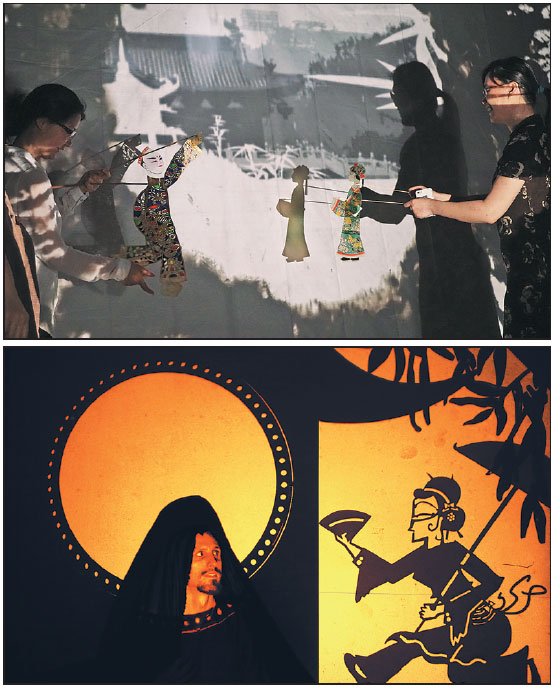Pulling the right strings
Updated: 2016-03-23 07:53
By Chen Nan(China Daily USA)
|
||||||||
It is one of the oldest performing arts in the world with a history dating back to the Song Dynasty (960-1279). Here, Li Rong, who runs the Mini Shadowplay Festival, preparing for its second edition in Beijing and Shanghai next month, explains how she fell in love with it and what she is doing to give it a makeover. Chen Nan reports.
When an art form is seen as living heritage, it not only indicates its historical and cultural value but also means it is in decline. That's how Li Rong thought about Chinese shadow puppetry, one of the oldest performing arts in the world with a history dating back to the Song Dynasty (960-1279), when it became part of UNESCO's Intangible Cultural Heritage of Humanity in 2011.
However, after seeing a series of live shadow puppetry shows staged at theaters in Huaxian county, Shaanxi province, in 2009, she developed a different perspective about the ancient art form, which led the 25-year-old to embark on a journey of researching, promoting and reviving it.
|
Top: Two volunteers display a shadow puppetry program combining traditional and modern elements during a workshop. Above: Evan Hastings introduces Chinese shadow puppetry during a summer program in 2014 in India. Photos Provided to China Daily |
"I was fascinated by the techniques of the puppeteers, such as improvisational singing, simultaneous manipulation of several puppets and their imagination. I did not want it to die," says Li, who graduated from the Beijing Language and Culture University in 2012.
In 2014, she decided to become a full-time promoter of the ancient art.
From 2009 to 2014, Li traveled to many places in China to watch shadow puppetry shows. She also visited Indonesia, Thailand and India, where shadow play has a long history, and where they are able to keep the tradition alive through religion.
Then, around two years ago, she read about Shadow Liberation, an interactive shadow theater ensemble directed by American drama therapist Evan Hastings, who uses shadow puppetry to talk about gender violence.
She contacted Hastings and over April 2-17, Hastings will be at Beijing's National Library and Shanghai's Theater of 1933 Old Millfun for the second edition of the Mini Shadowplay Festival. He'll be joined by five members of his theater group, including Rajeev Pulavar, an award-winning shadow puppeteer and educator from Kerala in southern India and Bengaluru-based theater artist, film actor Madhukar. They will deliver lectures, hold performances and conduct workshops.
They will use the Indian epic, the Ramayana, as an original text and will work on it with local artists to start a dialogue about gender equality.
"Last year, Hastings performed in Shanghai and Beijing as a solo artist," says Li, who founded Mini Shadowplay Festival in 2015. "Then, we opened up the backstage and let the audience get a taste of the shadow techniques. We will continue the interaction this year too."
In the festival's first year, with support from online funding, Li invited three veteran shadow puppetry artists from Xiangtan city in Hunan province. They not only performed at the event, but also interacted with the audience by displaying and teaching their craft of carving the puppets.
This year, the festival is partly funded by One Lab, a project under the charity organization One Foundation.
Li says that the performance last year was staged in the center of the venue, to enable the audience to see backstage.
Before the show, the artists wore traditional clothes and practiced a ritual - putting together the stage using bamboo sticks.
"Typically shadow puppetry theater is only about the performances, which are purely for entertainment. So the other details are rarely seen," says Li.
"However, many people these days want to be involved and experience the shadows first hand, instead of just watching them. So I thought this (letting the audience experience the preparations) is good for the development of Chinese modern shadow puppetry."
Hastings, 33, who was born in Seattle in the United States, shares Li's vision that shadow puppetry is a great art form when it comes to communicating between different groups of people.
A graduate from the Evergreen State College in Olympia, he moved to the San Francisco Bay Area to pursue a master's degree in drama therapy at the California Institute of Integral Studies in 2005.
Hastings founded Shadow Liberation in 2010 as a month-long intensive project for students at the Srishti Institute of Art, Design and Technology to engage in self-reflection about their gender socialization through drama therapy techniques.
"With the project, we were able to reach a wide range of audiences. We performed for urban poor children, international theater artists, college students and the general public from Bengaluru to Kolkata. After every show, audience members would approach us and share how moved they were by the performance," he says.
According to Li, the original function of shadow puppetry in China was to spread knowledge, promote cultural values and entertain people, but it has lost its appeal because of a lack of creativity. Besides, lots of aspects of shadow puppetry need to be redesigned and re-created to fit modern culture.
She gives examples of three Malaysians, who updated the old art using Star Wars and other pop-culture themes, and Thailand's shadow theater, called Nang Yai, which combines songs, chants and shadow puppets.
She says she was also inspired by a production, The Execution of the Judge of Hell, which had a traditional Chinese ghost story of revenge and retribution told using shadow puppets and Peking Opera.
The show premiered at the Croisement Festival in 2009. It was directed by French drama director Sarah Oppenheim in collaboration with a Beijing-based shadow puppetry theater group, the Hanfeizi Drama Club.
"I think about how to open up the possibilities for shadow puppetry, besides the Mini Shadowplay Festival," says Li.
"I want to invite people from different field to collaborate - ranging from dance to animation."
Contact the writer at chennan@chinadaily.com.cn
(China Daily USA 03/23/2016 page7)
- Police issue wanted notice for suspect after Brussels attacks
- China eyes cooperation plan for Lancang-Mekong countries
- Toronto's colorful former mayor Rob Ford dies of cancer
- NASA's Kepler sees first 'shock breakout' in exploding star
- First case of Zika virus detected in S.Korea
- Syrian mothers: Survival and loss

 Migrant couple returns to hometown to raise chickens
Migrant couple returns to hometown to raise chickens
 Victims of Brussels attacks commemorated
Victims of Brussels attacks commemorated
 In photos: Brussels rocked by multiple explosions
In photos: Brussels rocked by multiple explosions
 Raul Castro and Obama hold talks in Havana
Raul Castro and Obama hold talks in Havana
 Facebook's Mark Zuckerberg visits China's Great Wall
Facebook's Mark Zuckerberg visits China's Great Wall
 Apple releases smaller iPhones for new consumers
Apple releases smaller iPhones for new consumers
 China's 'sleep testers' search hotels for a good night's rest
China's 'sleep testers' search hotels for a good night's rest
 Practice makes perfect: Preparing for Boao forum
Practice makes perfect: Preparing for Boao forum
Most Viewed
Editor's Picks

|

|

|

|

|

|
Today's Top News
Marriott unlikely to top Anbang offer for Starwood: Observers
Chinese biopharma debuts on Nasdaq
What ends Jeb Bush's White House hopes
Investigation for Nicolas's campaign
Will US-ASEAN meeting be good for region?
Accentuate the positive in Sino-US relations
Dangerous games on peninsula will have no winner
National Art Museum showing 400 puppets in new exhibition
US Weekly

|

|
